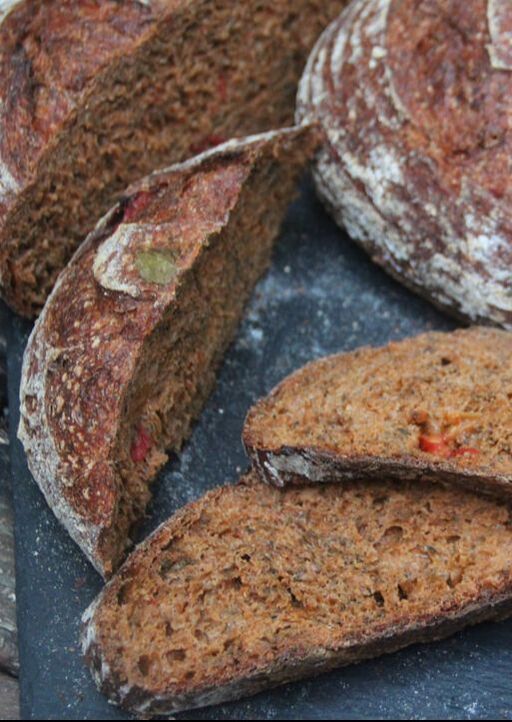|
TOMATO BASIL SOURDOUGH RECIPE This naturally leavened, red-tinged loaf is the epitome of summer. Whole rye gives it a denser crumb and a delicious tang to bring out the acidity of the tomatoes and the freshness of the basil. And paprika gives it a flavorful zing and deepens its natural color. Pair this loaf with some bruschetta or a Caprese salad or even just olive oil and herbs, and you're in for the perfect summer meal. Recipe yields 2 1-kg loaves. TOMATO BASIL SOURDOUGH BAKER'S PERCENTAGES (a universal, slightly more technical way to share recipes that is explained here, but you can also just ignore this)
TOMATO BASIL SOURDOUGH PROCESS
Mix
0 Comments
Rye is a magical, fearsome, and wholesome grain. Often grown as a cover crop, it's excellent at preventing field erosion over long winters and is relatively inexpensive for farmers. And rye is delicious for baking, especially when in naturally leavened breads.
Baking with rye is quite different than baking with wheat, especially in this 100% rye recipe, because of the grains' different chemical compositions. Rye still contains a type of gluten (a prolamin called secalin), but it can't create the same elastic bonds that wheat's gluten proteins (glutenins and gliadins) do. Instead, pentosans (a complex sugar present in rye that is also in wheat, but in lesser amounts) and starches are responsible for rye's crumb structure. When mixed with water, the pentosans in the rye swell and absorb large amounts of water, while its amalyse enzymes break down starches into sugar. But too much sugar and not enough starch will cause the rye bread's structure to collapse. Bakers refer to this as "starch attack." One way to slow down the enzyme activity and protect rye's crumb structure is to acidify the dough with sourdough starter. Another way is to use scalded, pre-gelatinized rye four as a portion of your dough. This recipe employs both techniques, and was developed for the Starrs Sourdough January 2020 sale. This is a 100% rye sourdough recipe with whole rye berries and sunflower, flax, and pumpkin seeds, using a rye sourdough starter. If you have a whole wheat or all-purpose wheat flour starter and don't want to make a new whole rye one, you can substitute in your own starter. The final dough won't be exactly 100% rye, but it'll be pretty close! The bakers percentages are listed alongside the ingredient weights, as well as for the total formula. RECIPE Yields one 1135-g loaf Levain 25g rye starter (20%) 125g whole rye flour (100%) 125g water (100%) Scald 125g whole rye flour (100%) 25g rye berries (20%) 25g sunflower seeds (20%) 25g flax seeds (20%) 25g pepitas (20%) 250g water (200%) Final mix 250g whole rye flour (100%) 125g water (50%) 10g salt (4%) (+ 475g scald and 275g levain) Total formula 500g whole rye flour (100%) 500g water (100%) 25g whole rye berries (5%) 25g sunflower seeds (5%) 25g pepitas (5%) 25g flax seeds (5%) 25g rye starter (5%) 10g salt (2%) EQUIPMENT Loaf pan Three bowls Mister or cast iron pan Plastic bowl scraper (helpful, but not required) Kitchen thermometer (helpful, but not required) PROCEDURE 1) Ensure your rye starter is active and bubbly by feeding it about 8 hours before you begin to mix your levain, and a day before you plan to begin your final mix. I usually feed my starter the morning of the day before I plan to bake. 2) 8-12 hours before your final mix, prepare your rye levain and scald. I usually do this the evening before I plan to bake.
3) The next morning, check your rye levain's activity level. When it seems to have reached its full expansion (about double its size when mixed the night before), combine the remaining mix ingredients.
4) Let ferment for 1 - 2 hours. 5) Line or spray a loaf pan and moisten or oil your hands. Then, scoop the dough into the tin and smooth the surface. This is where a plastic bowl scraper comes in handy. Sprinkle extra rye flour on the top of the loaf and place in a warm area. 6) Preheat oven to 500 degrees F. Ready your spray bottle/mister or place your cast iron pan at the bottom of the oven and boil more water about 30 minutes from your bake time. 7) Let bread proof for 1 - 2 hours. Rye doesn't rise anywhere near the same amount as wheat, or feel the same when poked. When the rye flour at the top develops cracks, it's a good indication that the bread is proofed. 8) Put the bread into the hot oven, and either mist with a spray bottle of water or pour boiling water into the cast iron pan at the bottom of the oven to create steam. Bake for 10 minutes at 500, then drop to 450 for 20 minutes, then 400 for about 30 more minutes. When the bread temperature is over 200 degrees F, remove from the oven to cool. 9) I recommend waiting at least 24 hours before cutting into this dense, nutty, aromatic loaf. Rye can be quite gummy if sliced earlier. It will last a week or more in your bread box or stored in a paper bag. |
|











